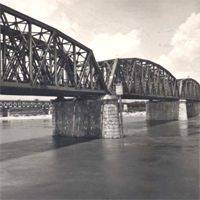Trains and the Italian Unification: the Time of the Railways Buildings
Abstract
The physical construction of modern Italy began in 1861, with the foundation of the Kingdom of Italy. The historical period coincided with the early industrial development of north-western Italy, and so the new infrastructure system developed in response, on the one hand, to the need to join together all the fragmentary pieces that formed the country and, on the other, to the general tendency to strengthen those areas that were economically and industrially stronger even before unification. The system that was being created in the 1860s by the Italian State before unification suffered continuous interruptions and was substantially without transverse connections, those with more difficult construction caused by the need to cross the Apennines. Within five years, from 1861 to 1866, the size of the railway system doubled, going from little more than 2,000 km to more than 4,000. The management of railway was entrusted to limited companies. The government guaranteed the company a contribution for each kilometer of railway built. In 1863 the tracks extended down the Adriatic coast as far as Brindisi, in order to attract the transit of the India Mail London- Brindisi-Bombay, the most important trade of the world. In 1863 Rome was linked to Naples, in 1864 the line from Bologna to Florence via Pistoia was opened, in 1866 Rome was linked to Florence and Ancona and in 1867 with Pisa. In 1874 the Genoa-Pisa line were completed as far as the frontier with France; later, in 1879 the Naples-Foggia line went into operation. In the same period some of the longer tunnels were opened. Those of Fréjus was realised between 1857 and 1871. The Gottardo tunnel came into being in 1882 and the Sempione tunnel in 1906. The opening of the alpine passes effectively permitted the connection of Italy to central Europe, flinging open the doors to more and more easily reachable markets. In last twenty years of the 19th century, in Italy began the strong development of the secondary railways, with a generalised movement to promote the branching out of the railway, as an instrument of progress. With the completion of the main lines, the outlying centers began to clamor for the trains that, in an agricultural society without for the moment the automobile, seemed the only tie with civilised life capable of bringing economic development and political and social modernisation. Italy was a country with an ancient infrastructure and numerous lively towns. These towns were often, in their municipal activity, the protagonists of the completion and management of a secondary railway system on the peninsula. The development of narrow gauge technology, that allowed narrower curves and steeper slopes thereby reducing the need for great engineering works, and the achievement of particular gripping systems like the rack railway, made it possible to link by rail the many small towns and villages located in the hills and on the slopes of mountains.
Downloads
References
“Le strade ferrate italiane esaminate sotto l’aspetto finanziario” (1893), Nuova Antologia, vol. 28°, 299.
Brilli A. (2006) Il viaggio in Italia. Storia di una grande tradizione culturale, Il Mulino, Bologna, 132.
Cavour C. (1976) Le strade ferrate in Italia, a cura di Salvestrini A., La Nuova Italia, Firenze, 61.
De Biase C. (1940) Il problema delle ferrovie nel Risorgimento italiano, Società tipografica modenese, Modena, 166-167.
Favaro A. (1870) Del traforo delle Alpi Cozie dal 1° gennaio 1869 al 31 marzo 1870 e di alcune questioni ad esso relative. Memoria letta alla R. Accademia di Scienze, Lettere ed Arti in Padova, 5-8.
Ferraris C.F. (1911) “Ferrovie”, in Cinquanta anni di storia italiana, Hoepli, Milano, vol. I, 2.
Lattari Da Fuscaldo F. (1846) Le strade ferrate e l’Italia, Napoli, 4.
Maggi S. (2003) Le ferrovie, Il Mulino, Bologna, 52.
Maggi S. (2010) “Il primo apparecchio elettrico. Invenzione e diffusione del telegrafo”, in Tecnica e spazio pubblico in Italia tra Ottocento e Novecento, a cura di Ragusa A., Lacaita, Manduria, 169-193.
A. Schram (1997), Railways and the formation of the Italian State in the nineteenth century, Cambridge University Press, Cambridge.
Valussi P. (1868) “Le piccole città nel nuovo ordinamento d’Italia”, Nuova Antologia, vol. VIII, 541.

Copyright (c) 2014 Tema. Journal of Land Use, Mobility and Environment

This work is licensed under a Creative Commons Attribution 4.0 International License.
Authors who publish in this journal agree to the following:
1. Authors retain the rights to their work and give in to the journal the right of first publication of the work simultaneously licensed under a Creative Commons License - Attribution that allows others to share the work indicating the authorship and the initial publication in this journal.
2. Authors can adhere to other agreements of non-exclusive license for the distribution of the published version of the work (ex. To deposit it in an institutional repository or to publish it in a monography), provided to indicate that the document was first published in this journal.
3. Authors can distribute their work online (ex. In institutional repositories or in their website) prior to and during the submission process, as it can lead to productive exchanges and it can increase the quotations of the published work (See The Effect of Open Access)
